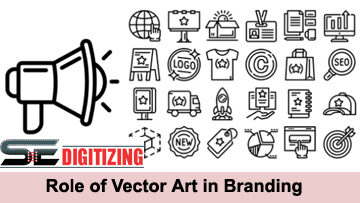Vector graphics are the most widely used form of artwork in branding. They are the perfect solution for any company because they allow you to scale your images. This makes them excellent when it comes to creating logos and marketing materials because they can be used across multiple channels without losing their integrity.
Vector graphics are often used in branding applications.
Vector graphics is a type of image that can be scaled to any size. Vector graphics are made up of lines and curves, which are created using a drawing program like Adobe Illustrator or Inkscape. Vector graphics are used in many different industries, including fashion, architecture, and games.
In branding applications, vector art is often used for logos because it can easily be scaled to any size while maintaining its crispness. The ability to scale something up or down lets you see how your design will look on very large billboards or very small business cards—without wasting money on printing large quantities of unneeded materials!
The graphics are used in the creation of brand logos, marketing materials, websites, and newsletters.
As you can see, vector graphics are used in the creation of brand logos, marketing materials, websites, and newsletters. Vectors can be scaled up or down to any size without losing detail. This makes them perfect for use on a website logo, where the size will vary depending on screen size.
Vectors are also easy to edit with programs like Adobe Illustrator and Inkscape, which makes them great for creating logos and graphics that will be used across multiple platforms or products.
As technology advances, businesses need to make sure that the logo and other branding elements are able to work everywhere.
Vector graphics are becoming more and more popular due to their ability to scale up or down without losing quality. This allows businesses to use their images on any size screen, from a smartphone screen to a billboard, easily.
Vector art can also be used in web design and print design. We have already talked about how vector art can be used for logos, marketing materials, websites, and newsletters, but they are also useful for web design, such as buttons, banners, or even text effects like scrollers. In fact, it’s pretty safe to say that almost every company uses vectors for everything from logos to website headers!
There was a time when vector graphics was limited to their use in the print industry.
Vector graphics is a type of digital image that is defined by its mathematical properties. It is composed of small lines and curves instead of pixels, like raster images.
Vector graphics were used in the print industry for decades before they became popular in web design, branding, and logo design. In fact, when it comes to logos—even today—more than 90% of all logos are created using vectors.
You can use vector graphics for many things, such as:
- Branding materials like brochures and business cards
- Web design, including banners, icons, and icons
- Marketing materials like postcards or flyers
Today with the rise of e-commerce and the growing trend of digitalization, you need to have a better understanding of how to use vector graphics.
If you are into branding, vector art is a great way to make your logo stand out. It’s also used in marketing materials, websites and newsletters.
Vector graphics have several advantages over raster images:
- They are more flexible than raster images. You can resize them because vector graphics contain geometrical information about the shapes, which is not present in a raster image.
- Vector graphics can be scaled as long as they fit within the constraints set by their container (such as a website or newsletter).
You can make your branding more effective with the help of vector art, and here are some ways.
Vector art is a great way to help make your branding more effective. The reason for this is that vector graphics can be used in many different ways and can be edited easily. Vector art is also scalable, meaning it can be used over any size.
You can use vector graphics for logos, brochures, websites, and other marketing materials. Since you don’t need to worry about whether or not your image will look good on different sizes of paper or screens, you have more freedom when designing your brand identity.
If you need help with creating a logo or making adjustments to it later on down the road, most freelancers will be able to do this using Adobe Illustrator software which allows them access features like resizing objects and changing colors easily by selecting an item from a palette menu instead of having manually erased sections of the original artwork line-by-line (which would take an extremely long time).
The role of vector graphics in branding is immense.
Vector graphics are used in a variety of ways. They’re used for logos, websites, and marketing materials; they’re also employed in print and digital media. When it comes to vector art graphics, the sky’s the limit! Vector art can be used anywhere from an online banner ad on Facebook or Instagram all the way down (or up!) to a beautiful business card design or something more automated like an e-book cover. With so many options available in vector art graphic design software today, it’s no wonder vector graphic usage has grown exponentially over recent years.
Conclusion:
The role of vector graphics in branding is immense. As a business owner, you need to make sure that your brand is represented in the right way, and this can be done with the help of vectors. You can create logos, images, and illustrations with these icons. The best part about using these images is that they can be used anywhere on any platform. It does not matter if you are creating a website or an e-commerce store because it will look great on all devices, which means a better customer experience for them as well!

